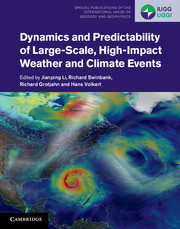Book contents
- Dynamics and Predictability of Large-Scale, High-Impact Weather and Climate Events
- Special publications of the International Union of Geodesy and Geophysics Series
- Dynamics and Predictability of Large-Scale High-Impact Weather and Climate Events
- Copyright page
- Contents
- Preface
- Frontispiece
- Book part
- Contributors
- Part I Diagnostics and prediction of high-impact weather
- Part II High-impact weather in mid latitudes
- 5 Rossby wave breaking: climatology, interaction with low-frequency climate variability, and links to extreme weather events
- 6 The influence of jet stream regime on extreme weather events
- 7 Forecasting high-impact weather using ensemble prediction systems
- 8 Storm tracks, blocking, and climate change: a review
- 9 The North Atlantic and Arctic Oscillations: climate variability, extremes, and stratosphere–troposphere interaction
- Part III Tropical cyclones
- Part IV Heat waves and cold-air outbreaks
- Part V Ocean connections
- Part VI Asian monsoons
- Index
- References
8 - Storm tracks, blocking, and climate change: a review
from Part II - High-impact weather in mid latitudes
Published online by Cambridge University Press: 05 March 2016
- Dynamics and Predictability of Large-Scale, High-Impact Weather and Climate Events
- Special publications of the International Union of Geodesy and Geophysics Series
- Dynamics and Predictability of Large-Scale High-Impact Weather and Climate Events
- Copyright page
- Contents
- Preface
- Frontispiece
- Book part
- Contributors
- Part I Diagnostics and prediction of high-impact weather
- Part II High-impact weather in mid latitudes
- 5 Rossby wave breaking: climatology, interaction with low-frequency climate variability, and links to extreme weather events
- 6 The influence of jet stream regime on extreme weather events
- 7 Forecasting high-impact weather using ensemble prediction systems
- 8 Storm tracks, blocking, and climate change: a review
- 9 The North Atlantic and Arctic Oscillations: climate variability, extremes, and stratosphere–troposphere interaction
- Part III Tropical cyclones
- Part IV Heat waves and cold-air outbreaks
- Part V Ocean connections
- Part VI Asian monsoons
- Index
- References
- Type
- Chapter
- Information
- Publisher: Cambridge University PressPrint publication year: 2016



